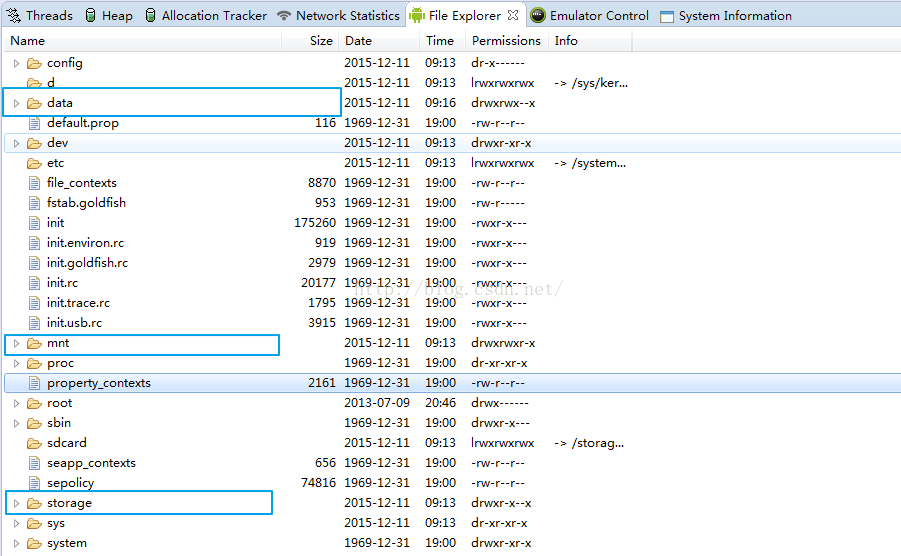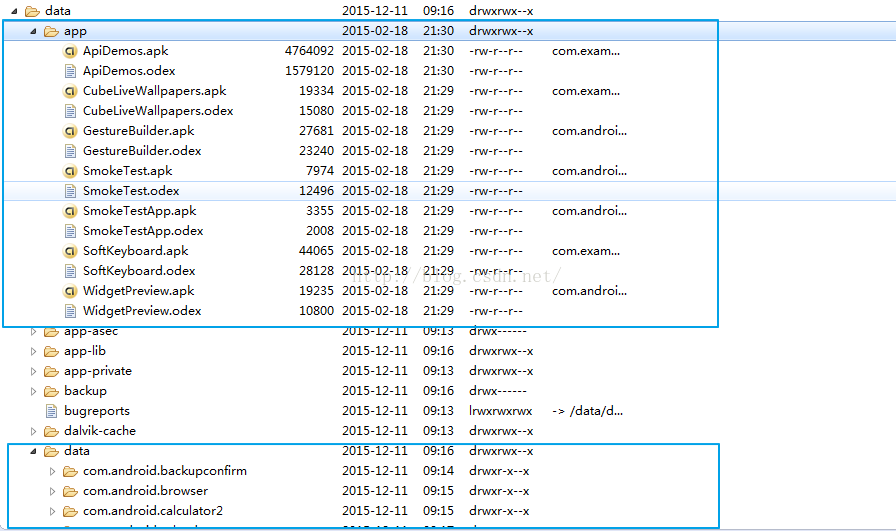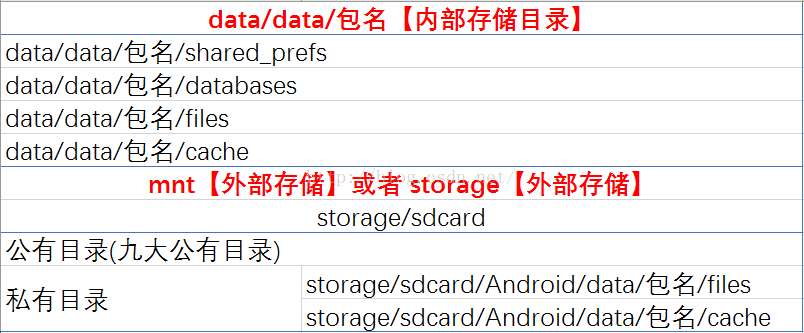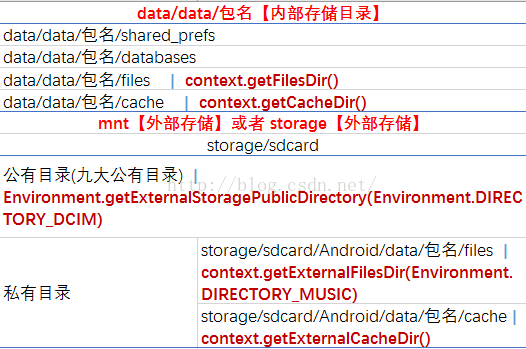我们先来考虑这样一个问题:
打开手机设置,选择应用管理,选择任意一个App,然后你会看到两个按钮,一个是清除缓存,另一个是清除数据,那么当我们点击清除缓存的时候清除的是哪里的数据?当我们点击清除数据的时候又是清除的哪里的数据?读完本文相信你会有答案。
在android开发中我们常常听到这样几个概念,内存,内部存储,外部存储,很多人常常将这三个东西搞混,那么我们今天就先来详细说说这三个东西是怎么回事?
内存,我们在英文中称作memory,内部存储,我们称为InternalStorage,外部存储我们称为ExternalStorage,这在英文中本不会产生歧义,但是当我们翻译为中文之后,前两个都简称为内存,于是,混了。
那么究竟什么是内部存储什么是外部存储呢?
首先我们打开DDMS,有一个File Explorer,如下:

这里有三个文件夹需要我们重视,一个是data,一个是mnt,一个是storage,我们下面就详细说说这三个文件夹。
1.内部存储
data文件夹就是我们常说的内部存储,当我们打开data文件夹之后(没有root的手机不能打开该文件夹),里边有两个文件夹值得我们关注,如下:

一个文件夹是app文件夹,还有一个文件夹就是data文件夹,app文件夹里存放着我们所有安装的app的apk文件,其实,当我们调试一个app的时候,可以看到控制台输出的内容,有一项是uploading …..就是上传我们的apk到这个文件夹,上传成功之后才开始安装。另一个重要的文件夹就是data文件夹了,这个文件夹里边都是一些包名,打开这些包名之后我们会看到这样的一些文件:
1.data/data/包名/shared_prefs
2.data/data/包名/databases
3.data/data/包名/files
4.data/data/包名/cache
如果打开过data文件,应该都知道这些文件夹是干什么用的,我们在使用sharedPreferenced的时候,将数据持久化存储于本地,其实就是存在这个文件中的xml文件里,我们App里边的数据库文件就存储于databases文件夹中,还有我们的普通数据存储在files中,缓存文件存储在cache文件夹中,存储在这里的文件我们都称之为内部存储。
2.外部存储
外部存储才是我们平时操作最多的,外部存储一般就是我们上面看到的storage文件夹,当然也有可能是mnt文件夹,这个不同厂家有可能不一样。
一般来说,在storage文件夹中有一个sdcard文件夹,这个文件夹中的文件又分为两类,一类是公有目录,还有一类是私有目录,其中的公有目录有九大类,比如DCIM、DOWNLOAD等这种系统为我们创建的文件夹,私有目录就是Android这个文件夹,这个文件夹打开之后里边有一个data文件夹,打开这个data文件夹,里边有许多包名组成的文件夹。
说到这里,我想大家应该已经可以分清楚什么是内部存储什么是外部存储了吧?好,分清楚之后我们就要看看怎么来操作内部存储和外部存储了。
3.操作存储空间
首先,经过上面的分析,大家已经明白了,什么是内部存储,什么是外部存储,以及这两种存储方式分别存储在什么位置,一般来说,我们不会自己去操作内部存储空间,没有root权限的话,我们也没法操作内部存储空间,事实上内部存储主要是由系统来维护的。不过在代码中我们是可以访问到这个文件夹的。由于内部存储空间有限,在开发中我们一般都是操作外部存储空间,Google官方建议我们App的数据应该存储在外部存储的私有目录中该App的包名下,这样当用户卸载掉App之后,相关的数据会一并删除,如果你直接在/storage/sdcard目录下创建了一个应用的文件夹,那么当你删除应用的时候,这个文件夹就不会被删除。
经过以上的介绍,我们可以总结出下面一个表格:

一目了然,什么是内部存储,什么是外部存储。
如果按照路径的特征,我们又可以将文件存储的路径分为两大类,一类是路径中含有包名的,一类是路径中不含有包名的,含有包名的路径,因为和某个App有关,所以对这些文件夹的访问都是调用Context里边的方法,而不含有包名的路径,和某一个App无关,我们可以通过Environment中的方法来访问。如下图:

大家看到,有包名的路径我们都是调用Context中的方法来获得,没有包名的路径,我们直接调用Environment中的方法获得,那么其中有两个方法需要传入一个String类型的参数,这个参数我们使用了Environment中的常量,参数的意思是我们要访问这个路径下的哪个文件夹,比如getExternalFilesDir方法,我们看看它的源码:
1 2 3 4 5 6 7 8 9 10 11 12 13 14 15 16 17 18 19 20 21 22 23 | /**** @param type The type of files directory to return. May be null for* the root of the files directory or one of* the following Environment constants for a subdirectory:* {@link android.os.Environment#DIRECTORY_MUSIC},* {@link android.os.Environment#DIRECTORY_PODCASTS},* {@link android.os.Environment#DIRECTORY_RINGTONES},* {@link android.os.Environment#DIRECTORY_ALARMS},* {@link android.os.Environment#DIRECTORY_NOTIFICATIONS},* {@link android.os.Environment#DIRECTORY_PICTURES}, or* {@link android.os.Environment#DIRECTORY_MOVIES}.** @return The path of the directory holding application files* on external storage. Returns null if external storage is not currently* mounted so it could not ensure the path exists; you will need to call* this method again when it is available.** @see #getFilesDir* @see android.os.Environment#getExternalStoragePublicDirectory*/@Nullablepublic abstract File getExternalFilesDir(@Nullable String type); |
它的注释非常多,我这里只列出其中一部分,我们看到,我们可以访问files文件夹下的Music文件夹、Movies文件夹等等好几种。
说到这里,我想大家对内部存储、外部存储该有了一个清晰的认识了吧。我们在开发中,不建议往内部存储中写太多的数据,毕竟空间有限。外部存储在使用的时候最好能够将文件存放在私有目录下,这样有利于系统维护,也避免用户的反感。
现在我们再来看看我们一开始提出的问题,当我们点击清除数据的时候清除的是哪里的数据呢?毫无疑问,当然是内部存储目录中相应的files和cache文件夹中的文件和外部存储中相应的files和cache文件夹中的文件,至于这些文件夹的路径我想你应该已经明白了。
好了,最后再送给大家一个文件操作工具类:
1 2 3 4 5 6 7 8 9 10 11 12 13 14 15 16 17 18 19 20 21 22 23 24 25 26 27 28 29 30 31 32 33 34 35 36 37 38 39 40 41 42 43 44 45 46 47 48 49 50 51 52 53 54 55 56 57 58 59 60 61 62 63 64 65 66 67 68 69 70 71 72 73 74 75 76 77 78 79 80 81 82 83 84 85 86 87 88 89 90 91 92 93 94 95 96 97 98 99 100 101 102 103 104 105 106 107 108 109 110 111 112 113 114 115 116 117 118 119 120 121 122 123 124 125 126 127 128 129 130 131 132 133 134 135 136 137 138 139 140 141 142 143 144 145 146 147 148 149 150 151 152 153 154 155 156 157 158 159 160 161 162 163 164 165 166 167 168 169 170 171 172 173 174 175 176 177 178 179 180 181 182 183 184 185 186 187 188 189 190 191 192 193 194 195 196 197 198 199 200 201 202 203 204 205 206 207 208 209 210 211 212 213 214 215 216 217 218 219 220 221 222 223 224 225 226 227 228 229 230 231 232 233 234 235 236 237 238 239 240 241 242 243 244 245 246 247 248 249 250 251 252 253 254 255 | public class SDCardHelper { // 判断SD卡是否被挂载 public static boolean isSDCardMounted() { // return Environment.getExternalStorageState().equals("mounted"); return Environment.getExternalStorageState().equals( Environment.MEDIA_MOUNTED); } // 获取SD卡的根目录 public static String getSDCardBaseDir() { if (isSDCardMounted()) { return Environment.getExternalStorageDirectory().getAbsolutePath(); } return null; } // 获取SD卡的完整空间大小,返回MB public static long getSDCardSize() { if (isSDCardMounted()) { StatFs fs = new StatFs(getSDCardBaseDir()); long count = fs.getBlockCountLong(); long size = fs.getBlockSizeLong(); return count * size / 1024 / 1024; } return 0; } // 获取SD卡的剩余空间大小 public static long getSDCardFreeSize() { if (isSDCardMounted()) { StatFs fs = new StatFs(getSDCardBaseDir()); long count = fs.getFreeBlocksLong(); long size = fs.getBlockSizeLong(); return count * size / 1024 / 1024; } return 0; } // 获取SD卡的可用空间大小 public static long getSDCardAvailableSize() { if (isSDCardMounted()) { StatFs fs = new StatFs(getSDCardBaseDir()); long count = fs.getAvailableBlocksLong(); long size = fs.getBlockSizeLong(); return count * size / 1024 / 1024; } return 0; } // 往SD卡的公有目录下保存文件 public static boolean saveFileToSDCardPublicDir(byte[] data, String type, String fileName) { BufferedOutputStream bos = null; if (isSDCardMounted()) { File file = Environment.getExternalStoragePublicDirectory(type); try { bos = new BufferedOutputStream(new FileOutputStream(new File(file, fileName))); bos.write(data); bos.flush(); return true; } catch (Exception e) { e.printStackTrace(); } finally { try { bos.close(); } catch (IOException e) { // TODO Auto-generated catch block e.printStackTrace(); } } } return false; } // 往SD卡的自定义目录下保存文件 public static boolean saveFileToSDCardCustomDir(byte[] data, String dir, String fileName) { BufferedOutputStream bos = null; if (isSDCardMounted()) { File file = new File(getSDCardBaseDir() + File.separator + dir); if (!file.exists()) { file.mkdirs();// 递归创建自定义目录 } try { bos = new BufferedOutputStream(new FileOutputStream(new File(file, fileName))); bos.write(data); bos.flush(); return true; } catch (Exception e) { e.printStackTrace(); } finally { try { bos.close(); } catch (IOException e) { // TODO Auto-generated catch block e.printStackTrace(); } } } return false; } // 往SD卡的私有Files目录下保存文件 public static boolean saveFileToSDCardPrivateFilesDir(byte[] data, String type, String fileName, Context context) { BufferedOutputStream bos = null; if (isSDCardMounted()) { File file = context.getExternalFilesDir(type); try { bos = new BufferedOutputStream(new FileOutputStream(new File(file, fileName))); bos.write(data); bos.flush(); return true; } catch (Exception e) { e.printStackTrace(); } finally { try { bos.close(); } catch (IOException e) { // TODO Auto-generated catch block e.printStackTrace(); } } } return false; } // 往SD卡的私有Cache目录下保存文件 public static boolean saveFileToSDCardPrivateCacheDir(byte[] data, String fileName, Context context) { BufferedOutputStream bos = null; if (isSDCardMounted()) { File file = context.getExternalCacheDir(); try { bos = new BufferedOutputStream(new FileOutputStream(new File(file, fileName))); bos.write(data); bos.flush(); return true; } catch (Exception e) { e.printStackTrace(); } finally { try { bos.close(); } catch (IOException e) { // TODO Auto-generated catch block e.printStackTrace(); } } } return false; } // 保存bitmap图片到SDCard的私有Cache目录 public static boolean saveBitmapToSDCardPrivateCacheDir(Bitmap bitmap, String fileName, Context context) { if (isSDCardMounted()) { BufferedOutputStream bos = null; // 获取私有的Cache缓存目录 File file = context.getExternalCacheDir(); try { bos = new BufferedOutputStream(new FileOutputStream(new File(file, fileName))); if (fileName != null && (fileName.contains(".png") || fileName.contains(".PNG"))) { bitmap.compress(Bitmap.CompressFormat.PNG, 100, bos); } else { bitmap.compress(Bitmap.CompressFormat.JPEG, 100, bos); } bos.flush(); } catch (Exception e) { e.printStackTrace(); } finally { if (bos != null) { try { bos.close(); } catch (IOException e) { e.printStackTrace(); } } } return true; } else { return false; } } // 从SD卡获取文件 public static byte[] loadFileFromSDCard(String fileDir) { BufferedInputStream bis = null; ByteArrayOutputStream baos = new ByteArrayOutputStream(); try { bis = new BufferedInputStream(new FileInputStream(new File(fileDir))); byte[] buffer = new byte[8 * 1024]; int c = 0; while ((c = bis.read(buffer)) != -1) { baos.write(buffer, 0, c); baos.flush(); } return baos.toByteArray(); } catch (Exception e) { e.printStackTrace(); } finally { try { baos.close(); bis.close(); } catch (IOException e) { e.printStackTrace(); } } return null; } // 从SDCard中寻找指定目录下的文件,返回Bitmap public Bitmap loadBitmapFromSDCard(String filePath) { byte[] data = loadFileFromSDCard(filePath); if (data != null) { Bitmap bm = BitmapFactory.decodeByteArray(data, 0, data.length); if (bm != null) { return bm; } } return null; } // 获取SD卡公有目录的路径 public static String getSDCardPublicDir(String type) { return Environment.getExternalStoragePublicDirectory(type).toString(); } // 获取SD卡私有Cache目录的路径 public static String getSDCardPrivateCacheDir(Context context) { return context.getExternalCacheDir().getAbsolutePath(); } // 获取SD卡私有Files目录的路径 public static String getSDCardPrivateFilesDir(Context context, String type) { return context.getExternalFilesDir(type).getAbsolutePath(); } public static boolean isFileExist(String filePath) { File file = new File(filePath); return file.isFile(); } // 从sdcard中删除文件 public static boolean removeFileFromSDCard(String filePath) { File file = new File(filePath); if (file.exists()) { try { file.delete(); return true; } catch (Exception e) { return false; } } else { return false; } }} |
本文相关笔记和源码下载http://download.csdn.net/detail/u012702547/9348985
转载请注明:Android开发中文站 » 彻底理解android中的内部存储与外部存储